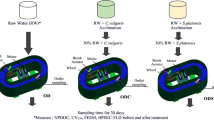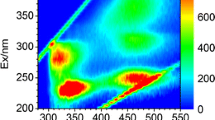Abstract
Filtration and cross-flow ultrafiltration techniques were used to separate culture media of Prorocentrum donghaiense at the exponential growth, stationary and decline stages into <0.45 µm filtrate, 100 kDa-0.45 µm, 10–100 kDa and 1–10 kDa retentate and <1 kDa ultrafiltrate fractions. The fluorescence properties of different molecular weights of dissolved organic matter (DOM) were measured by excitation-emission matrix spectra. Protein-like and humic-like fluorophores were observed in the DOM produced by P. donghaiense. The central positions of protein-like fluorophores showed a red shift with prolonged growth duration, shifting from tyrosine-like properties at the exponential growth stage to tryptophan-like properties at the stationary and decline stages. The excitation wavelengths of protein-like fluorophores exhibited some change in the exponential growth and stationary stages with increased molecular size, but showed little change in the decline stage. However, the emission wavelengths in the decline stage exhibited a blue shift. Very distinct C type and A type peaks in humic-like fluorophores were observed. With a prolonged culture time, the intensities of both of the peaks became strong and the excitation wavelengths of peak A showed a red shift, while the A:C ratios fell. More than 94% of fluorescent DOM was in the lower than 1 kDa molecular weight fraction.
Similar content being viewed by others
References
Chen R F, Bada J L. 1992. The fluorescence of dissolved organic matter in seawater. Mar. Chem., 37: 191–221.
Coble P G, Green S, Blough N V, Gagosian R B. 1990. Characterization of dissolved organic matter in the Black Sea by fluorescence spectroscopy. Nature, 348(29): 432–435.
Coble P G, Schultz C A, Mopper K. 1993. Fluorescence contouring analysis of DOC intercalibration experiment samples: a comparison of techniques. Mar. Chem., 41: 173–178.
Coble P G. 1996. Characterization of marine and terrestrial DOM in seawater using excitation-emission matrix spectroscopy. Mar. Chem., 51: 325–346.
Coble P G, Del Castillo C E, Avril B. 1998. Distribution and optical properties of CDOM in the Arabian Sea during the 1995 Southwest Monsoon. Deep-Sea Res., II 45: 2 195–2 223.
Dargan A I, Khrapunov S N, Protas A F, Berdyshev G D. 1983. The change in maximum position of tyrosyl fluorescence spectra of R Nase A and histone dimer (H2A-H2B) under denaturation. Stud. Biophys., 96: 187–193.
DeGrandpre M D, Vodacek A, Nelson R K, Bruce E J, Blough N V. 1996. Seasonal seawater optical properties of the U.S. Middle Atlantic Blight. J. Geophys. Res., 101: 22 727–22 736.
De Souza Sierra, M M, Donard O F X, Lamotte M, Belin C, Ewald M. 1994. Fluorescence spectroscopy of coastal and marine waters. Mar. Chem., 47: 127–144.
Eisinger J, Navon G. 1969. Fluorescence quenching and isotope effect of tryptophan. J. Chem. Phys., 50: 2 069–2 077.
Galla H J, Warnke M, Scheit K H. 1985. Incorporation of the antimicrobial protein seminalplasmin into lipid bilayer membranes. Eur. Biophys. J., 12: 211.
Guillard R R. 1975. Culture of phytoplankton for feeding marine invertebrates. In: Smith W L, Chanley M H eds, Culture of Marine Invertebrate Animals. Plenum Press, New York. USA. p: 29–60.
Harvey G R, Boran D A, Chesal L A, Tlkar J M. 1983. The structure of marine fulvic and humic acids. Mar. Chem., 12: 119–132.
Hayase K, Shinosuka N. 1995. Vertical distribution of fluorescence organic matter along with AUO and nutrients in the Equatorial Pacific. Mar. Chem., 48: 283–290.
Hayase K H, Tsubota I, Sunada, S. Goda. Yamazaki H. 1988. Vertical distribution of fluorescence organic matter in the North Pacific. Mar. Chem., 25: 273–281.
Hoge F E, Wright C W, Swift R N, Yungel J K, Berry R E, Mitchell R. 1998. Fluorescence signature of an iron enriched phytoplankton community in the eastern equatorial Pacific Ocean. Deep-sea Res., II 45: 1 073–1 082.
Ji N Y, Zhao W H, Cui X, Wang J T, Miao H, Wang L. 2004. Fluorescence characterization of dissolved organic matter in Jiaozhou Bay. Periodical of Ocean University of China, 34(Sup.): 197–203. (in Chinese with English abstract)
Ji N Y, Zhao W H, Wang J T, Cui X, Miao H. 2006. Fluorescence characteristics of dissolved organic matter during algal bloom in Jiaozhou Bay. Chinese Journal of Environmental Science, 27(2): 257–262. (in Chinese with English abstract)
Kalle K. 1949. Fluoreszenz und Gelbstoff im Bottnischen und Finnischen Meerbusen. Dtsch. Hydrogr. Z., 2: 117–124.
Lu K D, Goebel J. 2001. Five red tide species in genus Prorocentrum including the description of Prorocentrum donghaiense Lu sp. nov. from the East China Sea. Chin. J. Oceanol. and Limnol., 19(4): 337–344.
Matthews B J H, Jones A C, Theodorou N K, Tudhope A W. 1996. Excitation-emission-matrix fluorescence spectroscopy applied to humic acid bands in coral reefs. Mar. Chem., 55: 317–332.
Mayer L M, Schik L L, Loder T C. 1999. Dissolved protein fluorescence in two Maine estuaries. Mar. Chem., 64: 171–179.
Mopper K, Schultz C A. 1993. Fluorescence as a possible tool for studying the natural and water column distribution of DOC components. Mar. Chem., 41: 229–238.
Parlanti P, Worz K, Geoffroy L, Lamotte M. 2000. Dissolved organic matter fluorescence spectroscopy as a tool to estimate biological activity in a coastal zone subject to anthropogenic inputs. Org. Geochem., 31: 1 765–1 781.
Peterson H T. 1989. Determination of an Isochrysis galbana algal bloom by L-tryptophan fluorescence. Mar. Pollut. Bull., 20(9): 447–451.
Rochelle-Newall E J, Fisher T R, Fan C, Gilbert P M. 1999. Dynamics of chromophoric dissolved organic matter and dissolved organic carbon in experimental mesocosms. Int. J. Remote Sens., 20: 627–641.
Rochelle-Newall E J, Fisher T R. 2002. Production of chromophoric dissolved organic matter fluorescence in marine and estuarine environments: an investigation into the role of phytoplankton. Mar. Chem., 77: 7–21.
Stedmon C A, Markager S, Bro R. 2003. Tracing dissolved organic matter in aquatic environments using a new approach to fluorescence spectroscopy. Mar. Chem., 82: 239–254.
Stedmon C A, Markager S. 2005a. Resolving the variability in dissolved organic matter fluorescence in a temperate estuary and its catchment using PARAFAC analysis. Limnol. Oceanogr., 50(2): 686–697.
Stedmon C A, Markager S. 2005b. Tracing the production and degradation of authochronous fractions of dissolved organic matter by fluorescence analysis. Limnol. Oceanogr., 50(5): 1 415–1 426.
Traganza E D. 1969. Fluorescence excitation and emission spectra of dissolved organic matter in seawater. Bull. Mar. Sci., 19: 897–904
Wolfbeis O S. 1985. The fluorescence of organic natural products. In: Schulman J J ed., Molecular Luminescence Spectroscopy, Methods and Applications: Part I. Wiley, New York. p. 79–136.
Yamashita Y, Tanoue E. 2003. Chemical characterization of protein-like fluorophores in DOM in relation to aromatic amino acids. Mar. Chem., 82: 255–271.
Zhao W H, Wang J T, Cui X, Ji N Y. 2006. Research on fluorescence excitation and emission matrix spectra of dissolved organic matter in phytoplankton growth process. Chinese High Technology Letters, 16(4): 425–430. (in Chinese with English abstract)
Author information
Authors and Affiliations
Corresponding author
Additional information
Supported by the High Technology Research and Development Program of China (863 Program) (Nos. 2006AA09Z180 and 2004AA639790), the National Natural Science Foundation of China (No. 40106013), and the National Basic Research Program of China (973 Program) (No. 2001CB409703)
Rights and permissions
About this article
Cite this article
Zhao, W., Wang, J. & Chen, M. Three-dimensional fluorescence characteristics of dissolved organic matter produced by Prorocentrum donghaiense Lu. Chin. J. Ocean. Limnol. 27, 564–569 (2009). https://doi.org/10.1007/s00343-009-9141-z
Received:
Accepted:
Published:
Issue Date:
DOI: https://doi.org/10.1007/s00343-009-9141-z




